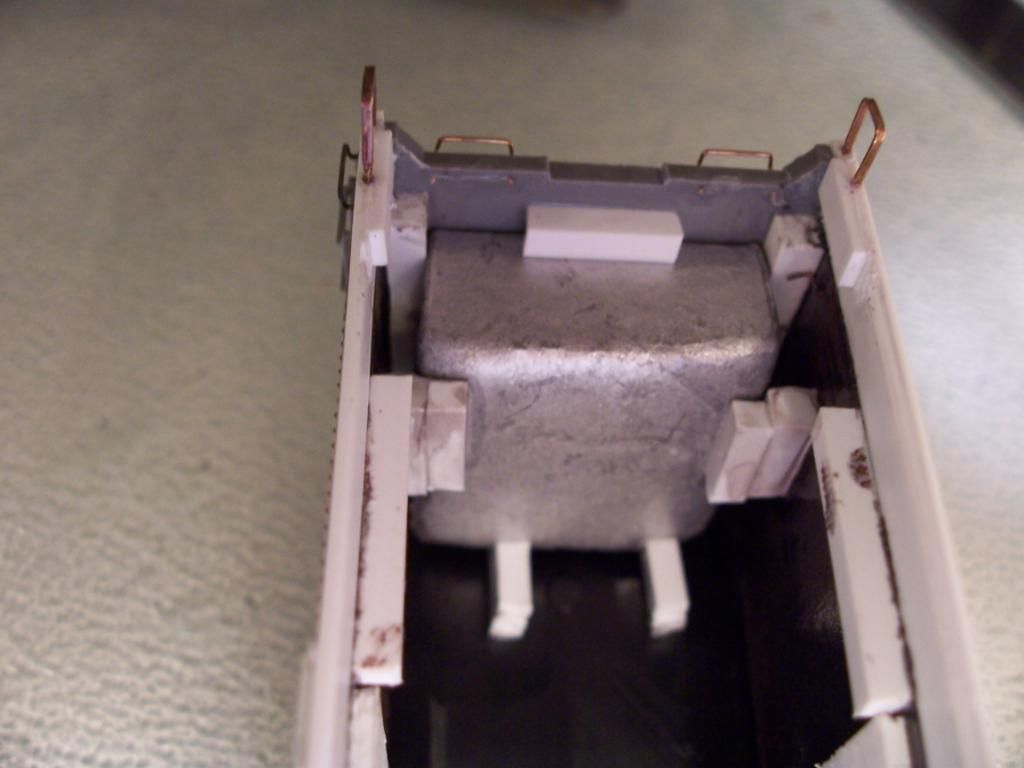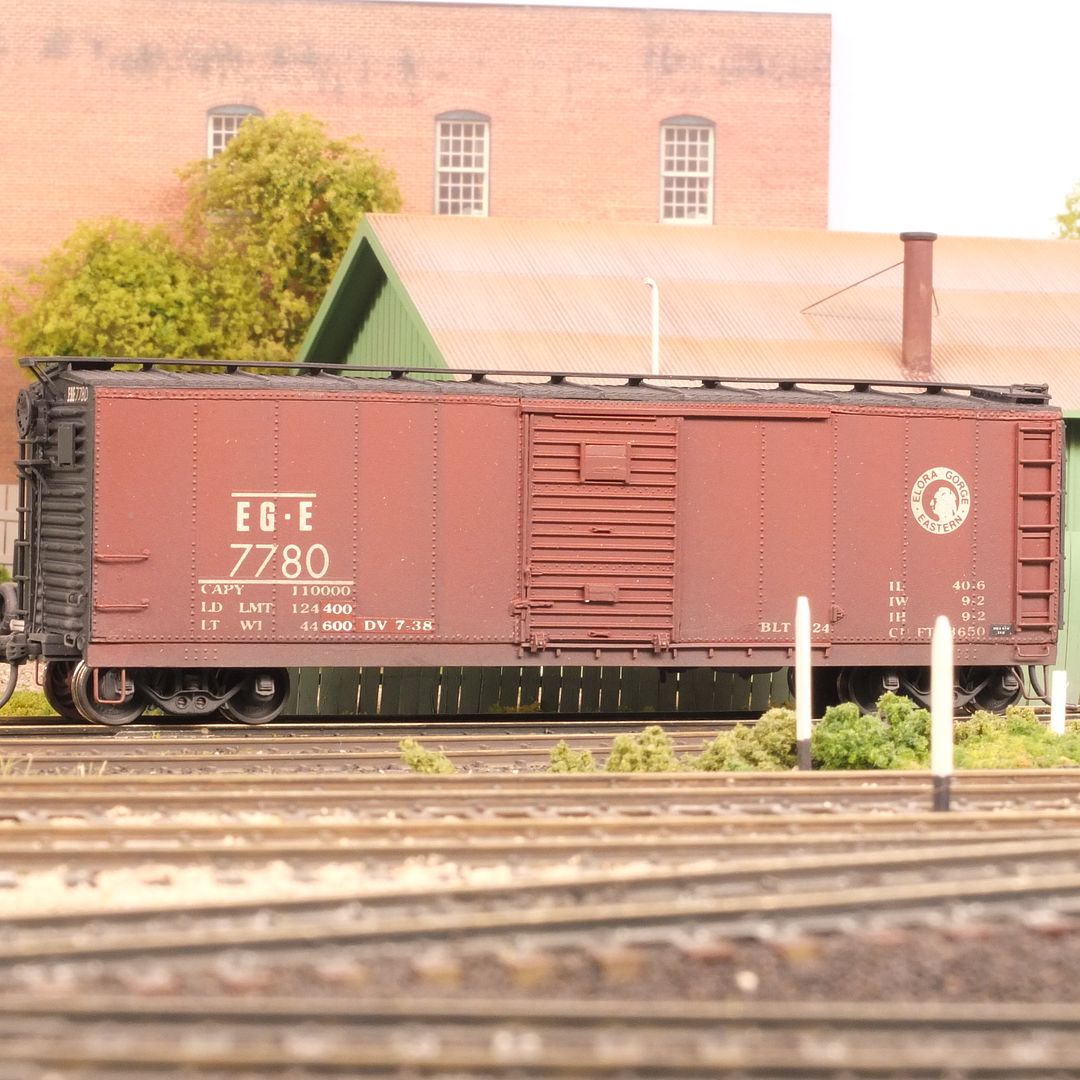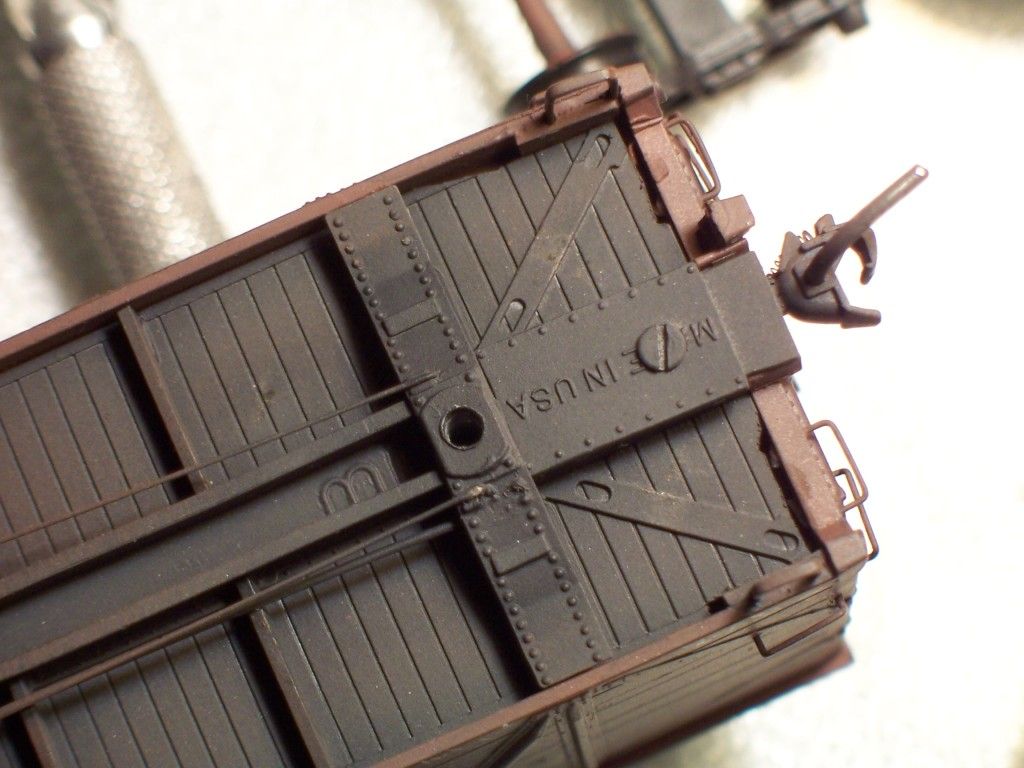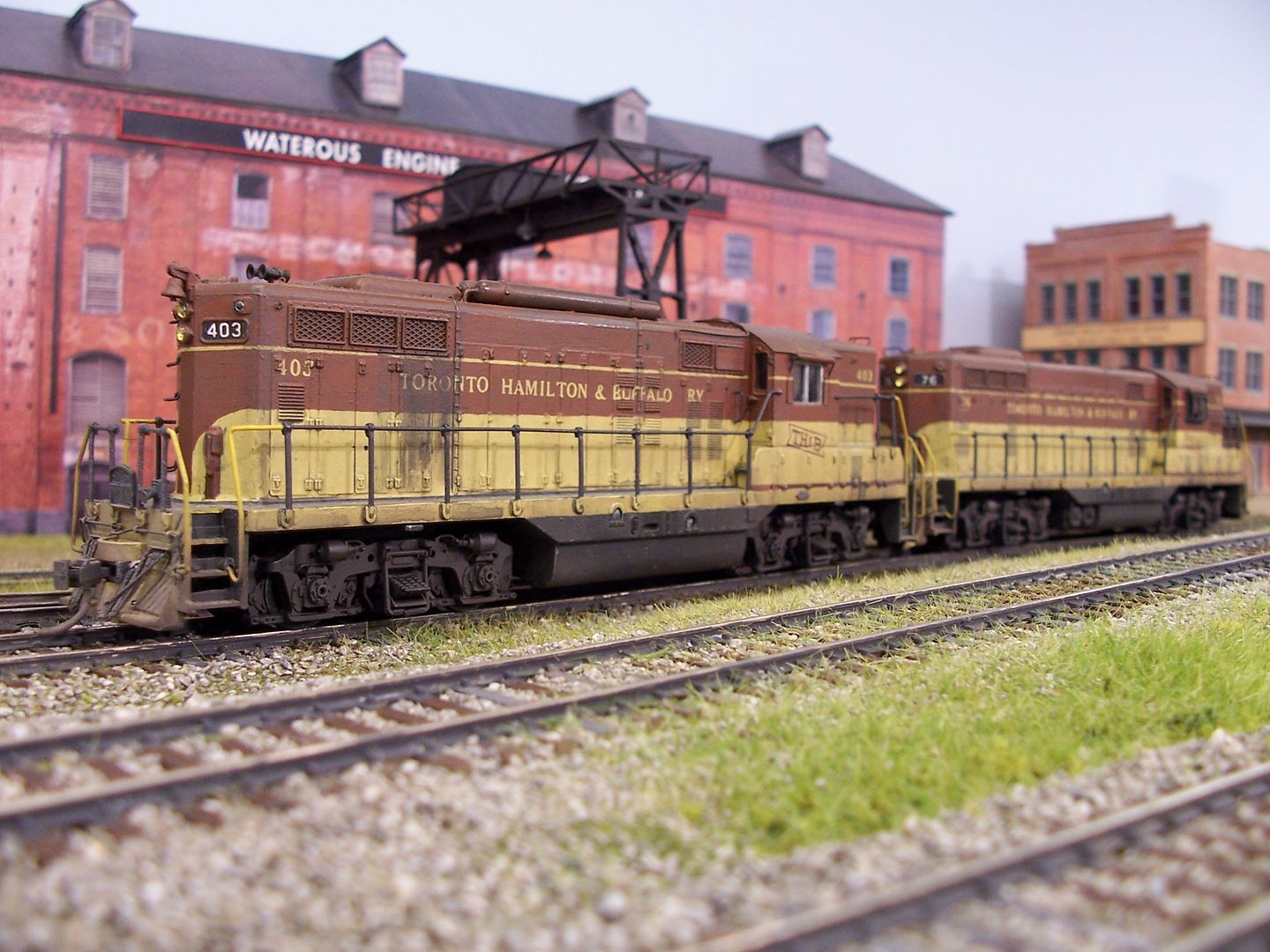Spray paint your model from a rattle can. Here is one of my rattle can painted locomotives. Dark gray auto primer, both Krylon and Rustoleum work well.
Scalecoat makes Milwaukee Road orange, by the way.
The On30 locomotive video was great, especially since the modeller uses the same desk mat I do!

-Kevin
About 40 years ago, I brush-painted these two modified Athearn Blue Box geeps, to match their prototypes, using Polly S paints (not the later and much improved PollyScale)…
Except for the number boards and the black pinstripes on the pilots, all of the lettering is painted.
Not too long after that, I did another two or three dozen in the same manner, before switching over to an airbrush for the last three dozen-or-so.
I used a good-quality brush and a decent paint that self-levelled before drying, so there are no brush marks. Many paints nowadays dry more rapidly, sometimes resulting in visible brush marks, while others self-level quickly, before beginning to dry.
While it didn’t take too long to become accustomed to using an airbrush, I still struggle with spray cans, and try to avoid using them. The only exception that has worked well for me was Tamiya’s Grey Primer in a spray can, which yielded results close to those achieved with an airbrush. I can’t say if Tamiya colours as sprays are comparable, as I’ve not used them, but I did get good results applying some Tamiya colours with a brush.
Regardless of whether you choose to brush-paint or spray-paint the final colours, I strongly suggest that you prime those locomotives with the Tamiya spray primer. Make sure that it’s fully-cured (no odour) before applying the final colours.
Wayne
Spray bomb = Rattle can. We mostly call them bombs because they are. See warning on the can about exposing to heat!!!
I second the Tamiya primer recommendation. That stuff is magic. If you’re after a flat grey final colour the Tamiya primer is good enough as a finish coat. I used it as a final coat to mimic anodizing on some camo painted aluminum arrow shafts I used as model sailing yacht masts and spars.
Tamiya primer is nice and thin, doesn’t run very easily and creates a very good bond between the unpainted surface and the final finish coat.
Before painting it is well worth giving the unpainted surface a thorough clean. I have good success using isopropyl alcohol (either pure 99% or 70% rubbing version seem to work equally well) followed by ordinary hand dishwashing soap and water and a clear water rinse. Even after careful hand drying it’s worth letting the model also dry in the air for an hour or more before applying primer.
I also second the recommendation to let that primer coat dry completely before applying a finish coat. I generally leave the primer for 24 hours minimum to dry.
Tamiya primer highlights any imperfections you may not have noticed on the plain shell which allows you to see and correct them before the final finish highlights them permanently.
I use gloss colours if I intend to apply decals then I dull kote the final product, including of course the fitted decals which I first spray with a light coat of decal fixer, to give that final flat look which seems
As always thanks for all the great information guys. Is there a one stop shop for all this stuff?
Heres a 40’ boxcar I practiced some more weathering on. Was my project for last night. Added 33" steel wheels and removed the old coupler box and replaced it with kadee #5s. Still need to work out the coupler height on the SW7

I went a little heavy in some parts that I need to go back and touch up, over all I am pleased with how this BB athearned turned out. Now I need to order paint and while I am waiting I need to get the layout to 80% completion.
Not really.
I have been getting my Vallejo Paints online from Mega Hobby. They carry everything. Their prices are not the best, but I have never had a problem with stock levels or service from them.
Tamiya I used to buy at local hobby shops, but that is no longer an option.
Citadel Paints are available at any game store that sells Games-Workshop products.
Winsor & Newton Series 7 brushes can be purchased at Dick Blick Art Supply online, as long as they are not banned from import, which happens from time to time.
That looks very good. Nice work. I hope you share some of that in Weekend Photo Fun.
In case you have not seen it, I posted a thread with my Athearn Blue Box assembly techniques here:
http://cs.trains.com/mrr/f/88/p/271360/3082289.aspx
Hmmm… the click link is not working. WHY CAN’T I GET LINKS TO WORK?
This might work:
http://cs.trains.com/mrr/f/88/p/271360/3082289.aspx
-Kevin
Ill have to check the one hobby shop a few minutes down the road. He has a big slection of games stuff along with tons of NOS HO stuff from the early 2000s
I forgot it was friday!
“… the click link is not working. WHY CAN’T I GET LINKS TO WORK?”
It seems to be a random software fault at the forum end. It doesn’t seem to matter whether you use the direct copy and paste method or the “tool” allowing inserting of a URL into your post.
I have noted that posting internal links to other pages in these forums frequently does not work.
I hope you can appreciate the humour of your post where the link you thought did not work actually did while the same link refused to work correctly the second time you tried in the very same post.
It is baffling and mildly irritating.
Many of my failed attempts have been corrected by other users, thanks to them for that help.
Nobody has yet explained this inexplicable random error.
I found that after inserting in the link from the button and then pasting in the URL, then pressing the OK button, I need to next enter a carriage return. If course, that means I can’t embed a link in the middle of a line, and I need that CR even at the very end of a post, but it always works for me.
Acrylic, oil or enamel?
I prefer to use the terms “water soluable” or “solvent soluable” when describing paints. It leads to much less confusion for my purposes.
Citadel, Vallejo, Turbo-Dork, and Reaper paints are all water soluable.
Note: Vallejo does make a small selection of metallic glazes that they call “alcohol based”, and these are not water soluable. I use disposable brushes when working with these.
-Kevin
Thanks kevin. I’m lucky enough to still have a LHS across the street from me (Literally, I can see if theyre open or closed by looking out my livingroom window!)
I will run in there today on my lunch and see what they have!
Kevin, your original link works just fine for me…did you go back and fix it?
I checked your thread on assmbling an Athearn car, and do use a few of the same methods, although most of mine are otherwise modified externally, usually to match a specific prototype.
I use cast lead weights, but locate them at the car’s ends to put the weight more-or-less directly over the trucks, which also prevents the floor from sagging…

Here’s the modified Blue Box car (one of eight), with new ends & doors (Tichy), new Viking roof (Des Plaines Hobbies), new underbody (Central Valley), and new trucks (Walthers/Proto). The car’s eaves have been lowered by about 6"(HO)

There’s a thread HERE showing a lot of freight car “improvements”, although the car shown above starts on page four of that post.
I’ve converted all of my Accurail cars to have screw-mounted trucks (no big-deal modifications, simply remove the push-in pegs, and replace them with 2-56 screws).
I also use screws to hold the coupler boxes and/or lids in place, using 2-56 flathead screws. I use a hand-held #19 drill bit to create a partial countersink, followed up by a few twists using a #41 bit. In most cases, the screwhead is either flush or very close to being so, almost unnoticeable on the layout…

On Train Miniature cars, I usually remove the cast-on draught gear boxes, and replace them w
I’ll give that a try.
I make a habit of isolating clickable links (URL or email) on their own line (return key above and below) to make it easier to click the link.
I even thought as I was typing “you know, in this community you’re likely to get shown…” and so I have been.[(-D]
…There have certainly been people who have successfully painted with a brush, and even more certainly people who weather with one. But I have yet to see something smaller than about O gauge that doesn’t show thick, irregular, or brush-mark artifacts when seen or imaged up close…
Your comment prompted me to take a look at those TH&B geeps, which I posted earlier. Viewed through my Optivisor, under very good lighting, there are no visible brush marks or surface irregularities apparent. They must have looked good enough to the buyers, too, as I did 66 of them, finally saved from doing more when factory-painted ones became available.
Those from Atlas and Proto are both better than mine, and were I modelling the diesel era, I’d use them.
I also looked at mine through a loupe, and there are brush marks…not surprising, I suppose, as there were multiple coats needed to not only achieve an evenly-opaque colour, but also because the lettering required each body shell to first be painted in the opposite colour of the final version.
That meant that the upper portion got two or three coats of the cream colour, and likewise for the lower portion, using the darker colour. The lettering was then applied, using dry transfer alphabet sets from C-D-S.
The shell was then painted again, two or three coats, but in the opposite colours used for the first applications.
As soon as the paint was dry-to-the-touch, I used small bits of masking tape to daub at the unburnished lettering, lifting-off the dry transfers and revealing the contrasting coloured lettering that was hidden below. In most cases, there was little or no touch-up needed.
However, there was no dry transfer lettering, at that time, for the TH&B herald, so they were done by hand, using a fine brush.
I’m still rather proud of being able to create a reasonably accurate model of the
I have been a sign painter since a junior in HS. I have of course gain quite a ot os skil in brush painting and can do it without brush marks. That said of course I also got into spray painting on a motor vehicle assembly line. Combining the two skills also led me to airbrush painting.
Have done all these I seem to go towards brush painting my models. I can get the effects I want and can even skip weathering afterwords. Every one should try both methods and you will discover which you are best at. Of course there is one other option…have someone else do it.[2c]
